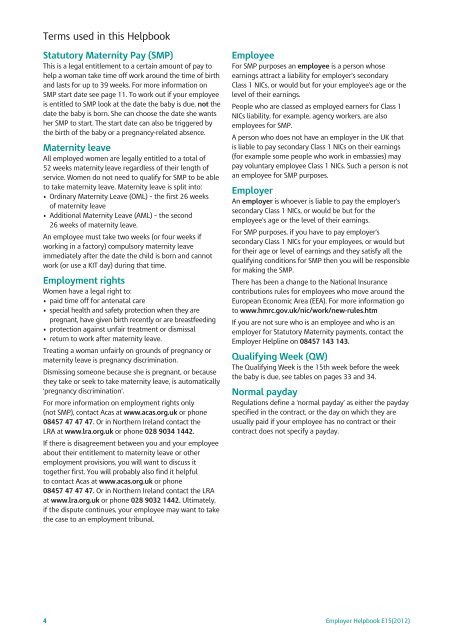Employer Helpbook for Statutory Maternity Pay - HM Revenue ...
Employer Helpbook for Statutory Maternity Pay - HM Revenue ...
Employer Helpbook for Statutory Maternity Pay - HM Revenue ...
You also want an ePaper? Increase the reach of your titles
YUMPU automatically turns print PDFs into web optimized ePapers that Google loves.
Terms used in this <strong>Helpbook</strong><br />
<strong>Statutory</strong> <strong>Maternity</strong> <strong>Pay</strong> (SMP)<br />
This is a legal entitlement to a certain amount of pay to<br />
help a woman take time off work around the time of birth<br />
and lasts <strong>for</strong> up to 39 weeks. For more in<strong>for</strong>mation on<br />
SMP start date see page 11. To work out if your employee<br />
is entitled to SMP look at the date the baby is due, not the<br />
date the baby is born. She can choose the date she wants<br />
her SMP to start. The start date can also be triggered by<br />
the birth of the baby or a pregnancy-related absence.<br />
<strong>Maternity</strong> leave<br />
All employed women are legally entitled to a total of<br />
52 weeks maternity leave regardless of their length of<br />
service. Women do not need to qualify <strong>for</strong> SMP to be able<br />
to take maternity leave. <strong>Maternity</strong> leave is split into:<br />
• Ordinary <strong>Maternity</strong> Leave (OML) – the first 26 weeks<br />
of maternity leave<br />
• Additional <strong>Maternity</strong> Leave (AML) – the second<br />
26 weeks of maternity leave.<br />
An employee must take two weeks (or four weeks if<br />
working in a factory) compulsory maternity leave<br />
immediately after the date the child is born and cannot<br />
work (or use a KIT day) during that time.<br />
Employment rights<br />
Women have a legal right to:<br />
• paid time off <strong>for</strong> antenatal care<br />
• special health and safety protection when they are<br />
pregnant, have given birth recently or are breastfeeding<br />
• protection against unfair treatment or dismissal<br />
• return to work after maternity leave.<br />
Treating a woman unfairly on grounds of pregnancy or<br />
maternity leave is pregnancy discrimination.<br />
Dismissing someone because she is pregnant, or because<br />
they take or seek to take maternity leave, is automatically<br />
‘pregnancy discrimination’.<br />
For more in<strong>for</strong>mation on employment rights only<br />
(not SMP), contact Acas at www.acas.org.uk or phone<br />
08457 47 47 47. Or in Northern Ireland contact the<br />
LRA at www.lra.org.uk or phone 028 9034 1442.<br />
If there is disagreement between you and your employee<br />
about their entitlement to maternity leave or other<br />
employment provisions, you will want to discuss it<br />
together first. You will probably also find it helpful<br />
to contact Acas at www.acas.org.uk or phone<br />
08457 47 47 47. Or in Northern Ireland contact the LRA<br />
at www.lra.org.uk or phone 028 9032 1442. Ultimately,<br />
if the dispute continues, your employee may want to take<br />
the case to an employment tribunal.<br />
4<br />
Employee<br />
For SMP purposes an employee is a person whose<br />
earnings attract a liability <strong>for</strong> employer’s secondary<br />
Class 1 NICs, or would but <strong>for</strong> your employee’s age or the<br />
level of their earnings.<br />
People who are classed as employed earners <strong>for</strong> Class 1<br />
NICs liability, <strong>for</strong> example, agency workers, are also<br />
employees <strong>for</strong> SMP.<br />
A person who does not have an employer in the UK that<br />
is liable to pay secondary Class 1 NICs on their earnings<br />
(<strong>for</strong> example some people who work in embassies) may<br />
pay voluntary employee Class 1 NICs. Such a person is not<br />
an employee <strong>for</strong> SMP purposes.<br />
<strong>Employer</strong><br />
An employer is whoever is liable to pay the employer’s<br />
secondary Class 1 NICs, or would be but <strong>for</strong> the<br />
employee’s age or the level of their earnings.<br />
For SMP purposes, if you have to pay employer’s<br />
secondary Class 1 NICs <strong>for</strong> your employees, or would but<br />
<strong>for</strong> their age or level of earnings and they satisfy all the<br />
qualifying conditions <strong>for</strong> SMP then you will be responsible<br />
<strong>for</strong> making the SMP.<br />
There has been a change to the National Insurance<br />
contributions rules <strong>for</strong> employees who move around the<br />
European Economic Area (EEA). For more in<strong>for</strong>mation go<br />
to www.hmrc.gov.uk/nic/work/new-rules.htm<br />
If you are not sure who is an employee and who is an<br />
employer <strong>for</strong> <strong>Statutory</strong> <strong>Maternity</strong> payments, contact the<br />
<strong>Employer</strong> Helpline on 08457 143 143.<br />
Qualifying Week (QW)<br />
The Qualifying Week is the 15th week be<strong>for</strong>e the week<br />
the baby is due, see tables on pages 33 and 34.<br />
Normal payday<br />
Regulations define a ‘normal payday’ as either the payday<br />
specified in the contract, or the day on which they are<br />
usually paid if your employee has no contract or their<br />
contract does not specify a payday.<br />
<strong>Employer</strong> <strong>Helpbook</strong> E15(2012)

















